-
PDF
- Split View
-
Views
-
Cite
Cite
V N Zirakashvili, V S Ptuskin, Role of the radiative stage for cosmic ray acceleration in SNRs, Monthly Notices of the Royal Astronomical Society, Volume 510, Issue 2, February 2022, Pages 2790–2796, https://doi.org/10.1093/mnras/stab3691
Close - Share Icon Share
ABSTRACT
We consider diffusive shock acceleration in supernova remnants throughout their evolution including a radiative stage. It is found that a more efficient acceleration and fast exit of particles at the radiative stage results in the hardening of the source cosmic ray proton and electron spectra at energies ∼100–500 GeV. The effect is stronger for cosmic ray electrons.
1 INTRODUCTION
Supernova remnants (SNRs) are considered now as a principle source of Galactic cosmic rays (CRs). It is believed that the diffusive shock acceleration (DSA) mechanism (Axford, Leer & Skadron 1977; Krymsky 1977; Bell 1978; Blandford & Ostriker 1978) operates in the vicinity of shocks in SNRs. During the last decades, the modern X-ray and gamma-ray observations supplied the evidence of the presence of multi-TeV energetic particles in these astrophysical objects (see e.g. Lemoine-Goumard 2014 for a review).
Usually, the existing DSA models are applied for young SNRs where the most energetic CRs are accelerated. However, lower energy particles are produced in older SNRs either. The investigation of CR acceleration in SNRs throughout all evolutionary stages is important for the calculation of overall CR spectra produced by SNRs.
In this paper, we describe the modifications of our non-linear DSA model (Zirakashvili & Ptuskin 2012) designed for investigation of DSA over the entire life of SNRs. The preliminary results on the application of this modified model to gamma-ray bright SNRs W28, W44, and IC443 were reported in Zirakashvili (2018) and Zirakashvili & Ptuskin (2016a, 2018a). The main new features are the gas ionization by the radiation of the remnant, radiative cooling of the gas, and damping of magnetohydrodynamic (MHD) waves on neutral atoms at the late stages of SNR evolution. We also performed the modelling of acceleration and production of broad-band electromagnetic emission in the young SNR Tycho and middle-aged SNR W44 to adjust the parameters of the model.
The paper is organized as follows. In Section 2, we describe our model. CR acceleration in IIP type SNRs evolving in the dense medium and modelling of non-thermal emission of SNR W44 is presented in Section 3. The modelling of Ia Type SNRs evolving in a more rarefied medium and the modelling of SNR Tycho are described in Section 4. The discussion of results and conclusions are given in Sections 5 and 6.
2 NON-LINEAR DIFFUSIVE SHOCK ACCELERATION MODEL
Details of our basic model of non-linear DSA can be found in Zirakashvili & Ptuskin (2012). The model contains coupled spherically symmetric hydrodynamic equations and the transport equations for energetic protons, ions, and electrons. The forward and reverse shocks are included in the consideration.
Damping of MHD waves due to the presence of neutral atoms is important for SNRs expanding in not fully ionized gas. To take this effect into account we add the equation that describes the transport and generation of MHD waves (see equation 5 below).
CR diffusion is determined by the scattering on magnetic inhomogeneities. The CR streaming instability increases the level of MHD turbulence in the shock vicinity (Bell 1978) and even significantly amplifies the absolute value of the magnetic field in young SNRs (Bell 2004; Zirakashvili & Ptuskin 2008a). It decreases the diffusion coefficient and increases the maximum energy of accelerated particles. The results of continuing theoretical study of this effect can be found in review papers (Bell 2014; Caprioli 2014).
CR particles are scattered by moving waves and it is why the CR advection velocity w may differ from the gas velocity u by the value of the radial component of the Alfvén velocity |$V_{Ar}=V_A/\sqrt{3}$| calculated in the isotropic random magnetic field: w = u + ξAVAr. The factor ξA describes the possible deviation of the CR drift velocity from the gas velocity. We use values ξA = 1 and ξA = −1 upstream of the forward and reverse shocks, respectively, where Alfvén waves are generated by the CR streaming instability and propagate in the corresponding directions.
The situation is less clear in the downstream region of the shocks. Usually, the Alfvén drift is not considered here. However, it is known that Alfvén transport in the downstream region suggested at phenomenological level (Zirakashvili & Ptuskin 2008b) results in steeper spectra of accelerated particles. This also allow avoiding a CR overproduction in evolutionary models of SNRs (Ptuskin et al. 2010).
Recently, the Alfvén transport in the downstream region was indeed observed in hybrid modelling of collisionless shocks (Haggerty & Caprioli 2020). It looks like some non-linear magnetic structures are generated in the shock transition and move with Alfvén speed in the downstream region. The origin of these non-linear waves is unclear. They can be large-scale transverse Alfvén-like waves propagating in the isotropic tangle magnetic field with phase speed |$V_A/\sqrt{3}$| (Moffatt 1986). Or they somehow can be related to sonic waves generated at the shock front.
Below we take the Alfvénic transport in the downstream region into account. We use values ξA = −1 and ξA = 1 just downstream of forward and reverse shocks, respectively. The Alvénic transport takes place in the narrow region of thickness 0.1 of the distance between the shock and the contact discontinuity.
The low seed level of the interstellar turbulence |$P_w=10^{-6}B_0^2/8\pi$| is prescribed at the simulation boundary at r = 2Rf. Since the flux of escaped highest energy particles amplifies waves exponentially in time the results depend only logarithmically on the seed level.
In the shock transition region, the wave pressure is increased by a factor of |$\sigma ^{\gamma _w}$|, where σ is the shock compression ratio. Its impact on the shock dynamics is taken into account via the Hugoniot conditions.
Below, we use the adiabatic index of Alfvén waves γw = 3/2. For this value of the adiabatic index, the wave pressure Pw = (δB)2/8π equals the wave magnetic energy density. The pressure of the regular field Pm plays a dynamical role at the radiative phase when the field is strongly compressed in the downstream region and produces a significant anisotropic force in the radial direction. To take this into account we use the adiabatic index γm = 2 for the regular magnetic field.
Two last terms in equation (6) correspond to the injection of thermal protons with momenta p = pf, p = pb and mass m at the forward and reverse shocks located at r = Rf(t) and r = Rb(t), respectively. The dimensionless parameters ηf and ηb determine the efficiency of injection.
The injection efficiency is taken to be independent of time ηf = 0.001, and the particle injection momentum is |$p_{f}=2m(\dot{R}_f-u(R_f+0,t))$|. Protons of mass m are injected at the forward shock and ions of mass M and mass to charge ratio A/Z = 2 and injection efficiency ηb = 0.001 are injected at the reverse shock.
For high Mach number shocks, this injection efficiency and Alfvén transport in the downstream region limit the pressure of accelerated particles and the magnetic energy density at the level |$10\!-\!20\ {{\ \rm per\ cent}}$| and |$1.5\ {{\ \rm per\ cent}}$| of the ram pressure of the shock, respectively. These numbers are comparable with ones observable in the hybrid modelling of collisionless shocks (Caprioli, Haggerty & Blasi 2020).
3 MODELLING OF DIFFUSIVE SHOCK ACCELERATION IN SNR OF IIP SUPERNOVA
A significant part of core-collapse supernova explosion occurs in molecular gas. The stars with initial masses below 12 M⊙ have no power stellar winds and therefore do not produce a strong modification of their circumstellar medium. The molecular cloud has been totally destroyed by stellar winds and supernova explosions of more massive stars at the instant of explosion. As a result, the star explodes in the inter-clump medium with the density 5–25 cm−3 (Chevalier 1999). Many such SNRs are observed in gamma rays now.
| Type . | SNR . | d . | Rf . | ESN . | Mej . | kSN . | B0 . | nH . | Xi0 . | Ri . | T . | Vf . | Bf . |
|---|---|---|---|---|---|---|---|---|---|---|---|---|---|
| . | . | kpc . | pc . | 1051 erg . | M⊙ . | . | |$\mu$|G . | cm−3 . | . | pc . | kyr . | km s−1 . | |$\mu$|G . |
| IIP | W44 | 2.8 | 12.35 | 1.8 | 10 | 9 | 5 | 7.0 | 0.01 | 4 | 23 | 160 | 51 |
| Ia | Tycho | 3.5 | 4.1 | 1.2 | 1.4 | 7 | 3 | 0.2 | 0.5 | 8 | 0.44 | 5300 | 210 |
| Type . | SNR . | d . | Rf . | ESN . | Mej . | kSN . | B0 . | nH . | Xi0 . | Ri . | T . | Vf . | Bf . |
|---|---|---|---|---|---|---|---|---|---|---|---|---|---|
| . | . | kpc . | pc . | 1051 erg . | M⊙ . | . | |$\mu$|G . | cm−3 . | . | pc . | kyr . | km s−1 . | |$\mu$|G . |
| IIP | W44 | 2.8 | 12.35 | 1.8 | 10 | 9 | 5 | 7.0 | 0.01 | 4 | 23 | 160 | 51 |
| Ia | Tycho | 3.5 | 4.1 | 1.2 | 1.4 | 7 | 3 | 0.2 | 0.5 | 8 | 0.44 | 5300 | 210 |
| Type . | SNR . | d . | Rf . | ESN . | Mej . | kSN . | B0 . | nH . | Xi0 . | Ri . | T . | Vf . | Bf . |
|---|---|---|---|---|---|---|---|---|---|---|---|---|---|
| . | . | kpc . | pc . | 1051 erg . | M⊙ . | . | |$\mu$|G . | cm−3 . | . | pc . | kyr . | km s−1 . | |$\mu$|G . |
| IIP | W44 | 2.8 | 12.35 | 1.8 | 10 | 9 | 5 | 7.0 | 0.01 | 4 | 23 | 160 | 51 |
| Ia | Tycho | 3.5 | 4.1 | 1.2 | 1.4 | 7 | 3 | 0.2 | 0.5 | 8 | 0.44 | 5300 | 210 |
| Type . | SNR . | d . | Rf . | ESN . | Mej . | kSN . | B0 . | nH . | Xi0 . | Ri . | T . | Vf . | Bf . |
|---|---|---|---|---|---|---|---|---|---|---|---|---|---|
| . | . | kpc . | pc . | 1051 erg . | M⊙ . | . | |$\mu$|G . | cm−3 . | . | pc . | kyr . | km s−1 . | |$\mu$|G . |
| IIP | W44 | 2.8 | 12.35 | 1.8 | 10 | 9 | 5 | 7.0 | 0.01 | 4 | 23 | 160 | 51 |
| Ia | Tycho | 3.5 | 4.1 | 1.2 | 1.4 | 7 | 3 | 0.2 | 0.5 | 8 | 0.44 | 5300 | 210 |
It is believed that the circumstellar medium is almost fully ionized by ultraviolet radiation from the remnant interior at the radiative stage (Chevalier 1999). The same is true for young SNRs because the gas is ionized by the radiation from the shock breakout and in the hot shock precursor produced by accelerated particles. Extended red supergiant progenitors of IIP Type supernovae emit ∼1048 erg of radiation during the shock breakout. This amount of energy is sufficient for the ionization of several dozens of solar masses of the circumstellar gas (Chevalier 2005). If so the shock propagates in the preionized medium at the free expansion phase and at the beginning of the Sedov stage. The amount of the breakout radiation is significantly smaller for compact progenitors of Ib/c and Ia type supernovae. However, Wolf–Rayet progenitors itself ionize ∼103M⊙ of surrounding gas before the explosion. Some level of the preionization is also expected for Ia Type supernovae because of the ionizing radiation of the accreting white dwarf. In this regard, the assumption of the full ionization is justified for almost all stages of the SNR evolution. The only probable exception is the end of the Sedov stage when the shock might propagate in the neutral medium. In this picture, the number density of neutrals nn is determined by the ionization history and by the recombination in ionized or preionized plasma.
Bright in GeV gamma-rays middle-aged SNR W44 at distance d = 2.8 kpc from the Earth is at the radiative phase now and shows signs of interaction with molecular gas (Reach, Rho & Jarrett 2005). It contains H i shell expanding with speed 135–150 km s−1 (Koo et al. 1995; Park et al. 2003).
The parameters of our supernova modelling are given in Table 1. The explosion parameters were adjusted to reproduce broad-band observations of SNR W44. The explosion energy ESN and ambient number density nH were adjusted to reproduce the expansion speed of H i shell and the observable gamma-ray flux.
The numbers in the three last columns of Table 1 that are the age T, shock speed Vf, and magnetic field strength Bf just downstream of the shock were obtained in the modelling.
We use the parameter of ejecta velocity distribution kSN = 9 (this parameter describes the power-law density profile |$\rho _{ej}\propto r^{-k_{SN}}$| of the outer part of the ejecta that freely expands after supernova explosion).
Figs (1)–(4) illustrate the results of our numerical calculations.
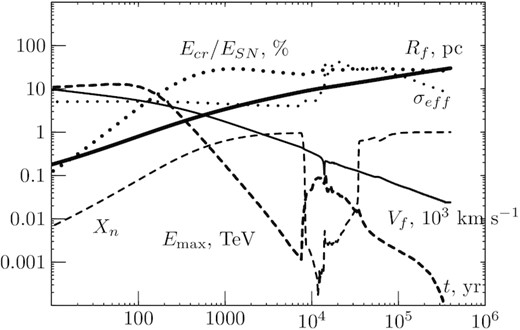
Dependence on time of the forward shock radius Rf (thick solid line), the shock speed Vf (thin solid line), the shock effective compression ratio σeff (thin dotted line), the maximum energy of particles accelerated at forward shock Emax (dashed line), the fraction of explosion energy transformed into CRs Ecr/ESN (thick dotted line) and neutral fraction Xn (thin dashed line) calculated for SNR of IIP supernovae.
The temporal evolution of the remnant and particle acceleration is illustrated in Fig. 1. The maximum energy of particles Emax at the forward shock was estimated as the energy where the function p5N(p) has a maximal value. The shock speed is almost constant at the initial free expansion stage. After 100 yr the Sedov stage begins. Maximum energy of particles is close to 20 TeV at this time. Later the maximum energy drops sharply because of the shock velocity decrease and because of the neutral damping of MHD waves. The neutral fraction Xn increases because of the recombination and later when the shock enters into a neutral medium. Strictly speaking the adequate description of DSA at this stage requires a kinetic treatment for the transport of neutral atoms near the shock (see Morlino et al. 2013). We leave the detailed description of the acceleration at this stage to the future. It seems that this stage does not produce a strong impact on results because the injection rate is proportional to the ionized fraction Xi and therefore the production rate of CRs at this phase is not high.
The ionizing radiation from the shock interior again ionizes the medium after 8 kyr. At this instant of time, the boundary of the ionization zone overtakes the forward shock. The acceleration efficiency increases because of higher injection rate.
Several thousand years after this the radiative stage begins when the cooling behind the shock results in the gas compression in this region and in the formation of a dense shell at the age T = 14 kyr. While the compression ratio of the shock is close to the standard value ∼4 the gas density continues to increase further downstream. To illustrate this we show in Fig. 1 the effective compression ratio σeff that is the ratio of the maximum gas density behind the shock to the ambient gas density. This ratio increases up to the value of 40 that is limited by the presence of CRs and regular magnetic fields. This gas compression results in a more efficient acceleration and in an enhanced flux of runaway highest energy particles. This, in turn, produces some temporary constant level of the maximum energy. In addition, the gas cooling behind the shock is accompanied by its recombination. The neutral gas of the shell absorbs the ionizing radiation from the hot remnant interior. This stops ionization in the far upstream region and gas ionized earlier begins to recombine. Particles accelerated earlier leave the neutral shell because of the damping of MHD waves. At 35 kyr, the shock reaches the boundary of the ionized region and enters the neutral medium. At later times the acceleration at the forward shock does not occur.
It should be noted that we use a simplified approach for the description of the radiative cooling and photoionization with the equilibrium cooling functions Λ(Te) and Λi(Te). In reality, radiative cooling and photoionization depend on the ionization state of ions in plasma that is not in thermal equilibrium. However, we checked by performing a test run without CRs that the reionization, the dense shell formation, and exit of the shock to the neutral medium occur at the same age as in the SNR modelling with a full application of the atomic physics (Sarkar, Gnat & Sternberg 2021).
Radial dependences of physical quantities in SNR W44 at present (T = 23 kyr) are shown in Fig. 2. The gas temperature drops sharply downstream of the forward shock due to the radiative cooling and a thin neutral dense shell is formed behind the forward shock. We obtain the shell mass of the neutral Hydrogen 640 M⊙ that is somewhat higher than the measured value of 390 M⊙ (Park et al. 2003). The central part of the remnant is filled by the hot rarefied gas with a temperature of 106–107K.
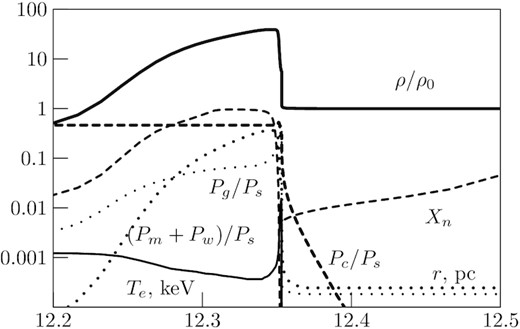
Radial dependences of the gas density (thick solid line), the gas temperature Te (thin solid line), CR pressure (thick dashed line), neutral fraction Xn (dashed line), the magnetic energy density B2/8π = Pm + Pw (dotted line), and the gas pressure Pg (thin dotted line) at T = 23 kyr in the vicinity of the forward shock in SNR W44. The pressures are normalized to the ram pressure of the shock |$P_s=\rho _0V^2_f$|.
Results of multiband modelling of SNR W44 are shown in Fig. 3. Thermal emission has two components. One is produced by the hot gas in the remnant interior while the lower energy component is produced by the dense gas that cooled and recombined behind the shock front. This gas produces a significant amount of the thermal radio emission that dominates the synchrotron radio emission at high frequencies.
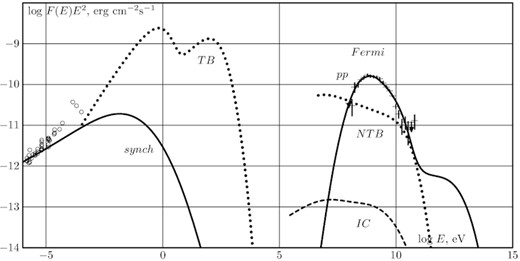
The results of modelling of electromagnetic radiation of W44. The following radiation processes are taken into account: synchrotron radiation of accelerated electrons (solid curve on the left), IC emission (dashed line), gamma-ray emission from pion decay (solid line on the right), thermal bremsstrahlung (dotted line on the left), non-thermal bremsstrahlung (dotted line on the right). Experimental data in gamma-rays by the Fermi LAT (Ackermann et al. 2013) (data with error bars) and in radio bands (Castelletti et al. 2007; Arnaud et al. 2016) (circles) are also shown.
The spectra of particles Nint produced during 400 kyr after supernova explosion are shown in Fig. 4. They are calculated via the integration throughout the simulation domain and via the integration on time of the outward diffusive flux at the simulation boundary at r = 2Rf. About |$26{{\ \rm per\ cent}}$| of the kinetic energy of the explosion is transferred to CRs. Almost all this energy is gone with escaped particles. Note that almost all protons and electrons accelerated at the forward shock have left the remnant. This is because the neutral damping of MHD waves, which confine CRs, was taken into account in the downstream region. In this regard, the proton and electron spectra shown in Fig. 4 are the source spectra of galactic CRs. This is not so for the ion spectrum. A significant part of ions accelerated at the reverse shock are still confined in the central part of the remnant, where the gas is fully ionized. The exit of particles from the ionized regions of SNR is regulated by another kind of damping of MHD waves that is not considered here.

Spectra of protons (thick lines) and electrons (thin lines) produced at the forward shock, and nuclei (normal lines) produced at the reverse shock in SNR of Type IIP during 400 kyr after explosion. The spatially integrated spectra of particles (dotted lines), the spectra of particles escaped from the remnant (dashed lines), and the sum (solid lines) are shown.
As was mentioned before the acceleration efficiency increases just before and after the transition to the radiative stage. The corresponding CR spectra of protons and electrons show a spectral hardening at several hundreds GeV. The effect is stronger for electrons because their injection rate increases with time according to equation (13).
4 MODELLING OF DSA IN SNR OF TYPE IA SUPERNOVA
The parameters of supernova modelling are given in Table 1. The explosion parameters were adjusted to reproduce multiwave observations of young SNR Tycho. The distance to this SNR is very uncertain. So we fix the explosion energy to a value ESN = 1.2 × 1051 erg of the 1D delayed detonation model of the Tycho supernova explosion (Badenes et al. 2006). Then the distance and the ambient number density nH were adjusted to reproduce the age of SNR and its angular diameter of 8 arcmin. The parameter hw = 0.7 in equations (3),(5), and (8) was adjusted to reproduce the observable gamma-ray spectrum.
It was assumed that about 5 solar masses of Hydrogen is ionized before and during the supernova explosion.
Figs (5)–(8) illustrate the results of our numerical calculations.
The remnant evolves in a low-density medium. That is why the transition to the radiative stage occurs at 100 kyr. The regular magnetic field produces a stronger limitation of σeff ∼ 10 at this stage.
Spectra of accelerated in Tycho SNR protons, ions, and electrons at present are shown in Fig. 6. They are rather soft due to the Alfvénic transport in the downstream region. This also provides a good agreement with radio, X-ray, and gamma-ray data (see Fig. 7).
The spectra of particles Nint produced during 4 Myr after supernova explosion are shown in Fig. 8. They are calculated via the integration throughout the simulation domain and via the integration on time of the outward diffusive flux at the simulation boundary at r = 2Rf. About |$19{{\ \rm per\ cent}}$| of the kinetic energy of the explosion is transferred to CRs. Almost all this energy is gone with escaped particles. The maximum energy of escaped particles is 50 TeV for this SNR. Similar to the case of IIP type SNR almost all accelerated protons and electrons left the remnant and their spectra can be considered as source spectra of galactic CRs.
The energy of the hardening is lower for Ia Type SNRs. Note that transition to the radiative stage occurs when the shock radius is 40 pc. Probably in many cases, the shock will collide with a denser medium before the transition. Then the situation will be similar to the one considered in the previous section.
5 DISCUSSION
In the absence of damping the maximum energy Emax of accelerated particles can be found from the condition that the magnetic field amplified by the CR streaming instability has enough time to grow from the initial value of Bb, that is ΓcrT = ln (B/Bb) ∼ 10 during the age T.
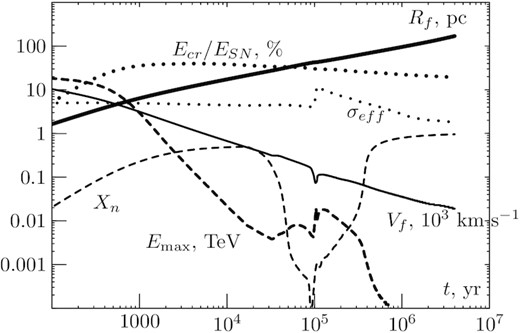
Dependence on time of the forward shock radius Rf (thick solid line), the shock speed Vf (thin solid line), the effective shock compression ratio σeff (thin dotted line), the maximum energy of particles accelerated at forward shock Emax (dashed line), the fraction of explosion energy transformed into CRs Ecr/ESN (thick dotted line) and neutral fraction Xn (thin dashed line) calculated for SNR of Ia supernovae.
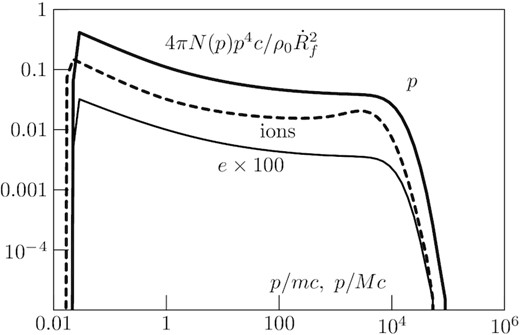
The spectra of particles in Tycho SNR. Proton and electron spectra at the forward shock and spectrum of ions accelerated at the reverse shock are shown.
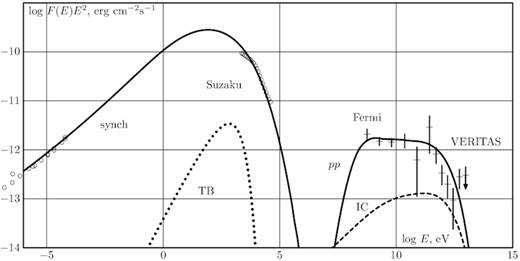
The results of modelling of electromagnetic radiation of Tycho SNR. The following radiation processes are taken into account: synchrotron radiation of accelerated electrons (solid curve on the left), IC emission (dashed line), gamma-ray emission from pion decay (solid line on the right), thermal bremsstrahlung (dotted line on the left). Experimental data in gamma-rays by the Fermi LAT and VERITAS (Archambault et al. 2017); (data with error bars), radio (Klein et al. 1979), and analytical approximation of continuum X-rays by Suzaku (Tamagawa et al. 2009) (circles) are also shown.
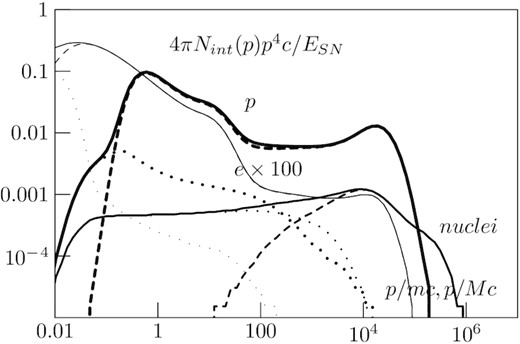
Spectra of protons (thick lines) and electrons (thin lines) produced at the forward shock, and nuclei (normal lines) produced at the reverse shock in SNR of Type Ia during 4 Myr after explosion. The spatially integrated spectra of particles (dotted lines), the spectra of particles escaped from the remnant (dashed lines), and the sum (solid lines) are shown.
So the maximum energies determined by CR streaming instability are not higher than 100 TeV in SNRs considered. Higher energies can be reached for SNRs shocks propagating in rarefied bubbles created by Type Ib/c supernova progenitors where the medium is prepared for the efficient DSA (Zirakashvili & Ptuskin 2018b, 2021) or in dense progenitor winds of IIn Type SNRs (Zirakashvili & Ptuskin 2016b).
It is expected that the effect will be similar for light CR nuclei. However, details of the ionization, e.g. a high ionization potential of the Helium can result in some peculiarities of the hardening.
We expect that the effect of the hardening can be different for heavy nuclei. The matter is that the nuclei injected into DSA are single or double charged. The further ionization occurs via collisions with thermal particles (a so-called stripping) and a photoionization. The photoionization is possible when accelerated particles reach high Lorentz factors and interact with optical, infrared, and microwave background photons (Morlino 2011). For example, it takes ∼105 yr for a full ionization of Iron nuclei with a Lorentz factor 100 accelerated in SNR evolving in the dense gas with a number density of 10 cm−3 (see fig. 1 of Morlino 2011). This time is higher than the age of the transition to the radiative stage ∼104 yr. Actually, the heavy nuclei have the time for the ionization up to the charge state ∼10. They will be stripped further after the end of the acceleration and during a propagation in the Galaxy. Therefore, it is expected that heavy nuclei have lower observable rigidities of the hardening.
It is important to note that high-energy measurements of protons and nuclei energy spectra in the CR experiment AMS confirm the earlier experimental results of ATIC-2, CREAM, and PAMELA measurements on the presence of spectral hardening at magnetic rigidity at about 200 GV (see e.g. review of Serpico 2018, and references therein). Some peculiarities for the hardening of Iron nuclei were also reported (Schroer, Evoli & Blasi 2021).
The nature of this hardening is not clear yet. In principle, it may reflect the source spectra or the peculiarity of the energy dependence of CR leakage time from the Galaxy.
In our modelling, the hardening at energies 100–500 GeV in the source proton and electron spectra is related with a higher acceleration efficiency after the full reonization of the medium just before the beginning of the radiative stage and with the strong gas compression behind the shock at the radiation stage. Probably this spectral feature is also presented in the energy dependence of the CR leakage time because of the self-confinement of CRs (see a review of Blasi 2019, and references therein). In self-confinement models, CRs generate MHD waves via CR streaming instability. These waves in turn scatter CR particles and regulate their diffusion and confinement in the Galaxy. The streaming instability is produced mainly by protons and α-particles. So the hardening in their source spectra will result in a change of the energy dependence of the interstellar diffusion coefficient.
6 CONCLUSION
Our results and conclusions are the following:
We performed the modelling of particle acceleration in SNRs up to the late stages of the remnant evolution when almost all particles accelerated at the forward shock have left the remnant.
We show that transition to the radiative phase of SNRs is accompanied by a higher acceleration efficiency of CRs. It leads to the hardening of the CR proton and electron source spectrum at energies of several hundreds GeV. This energy is simply the maximum energy of accelerated particles at the time of the transition. CR particles at lower energies are mainly accelerated and escaped the remnant at the radiative stage.
The effect is stronger for CR electrons because of the higher electron injection rate in old SNRs.
We expect that the effect is different for heavy nuclei because of the partial ionization.
ACKNOWLEDGEMENTS
The work was partially supported by the Russian Foundation for Basic Research grant 19-02-00043. The work was also partly performed at the Unique scientific installation ‘Astrophysical Complex of Moscow State University - Irkutsk State University’ (agreement 13.UNU.21.0007). We also thank the referee Luke Drury for valuable comments.
DATA AVAILABILITY
All results in this paper were obtained using available published data.



